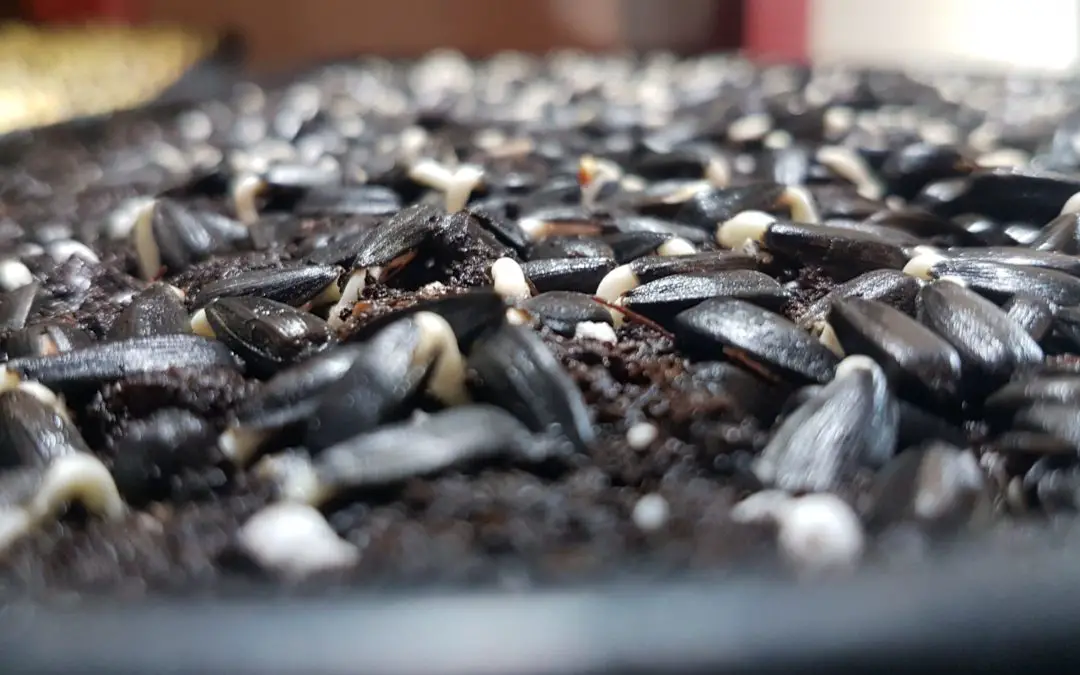Sunflower microgreens are some of the most nutrient dense, they have a substantial texture and great flavor, but the big downside is dealing with the hulls. Most microgreens shed their hulls easily, but sunflowers take a bit of experimentation to get it right! Luckily, I’ve done some work piecing it together, and I’m happy to share everything I know.
To grow microgreens without hulls clinging on, start with strong fresh seeds. Switch suppliers if you’re not getting good results, and ask your supplier to send you the freshest seeds possible. Don’t buy pre-hulled seeds. From soaking to harvest aim for 20 -25C (68-77F). Soak your seeds for a minimum of 6 hours in a 0.5% hydrogen peroxide water solution. Put half an inch of screened seedling mix or potting soil, then spread seeds evenly at approximately 150g (5.3 oz) per 10×20 tray, then top-dress with another ½ inch of soil. Water. Cover with another tray, weight it down, and leave for 3.5 days to germinate.
If you did all of the above steps, you’ve won half the battle. Your seeds should germinate more evenly, and during harvest you’ll have less hulls to deal with. Read on for more detail!
Theory on how seed hulls are shed
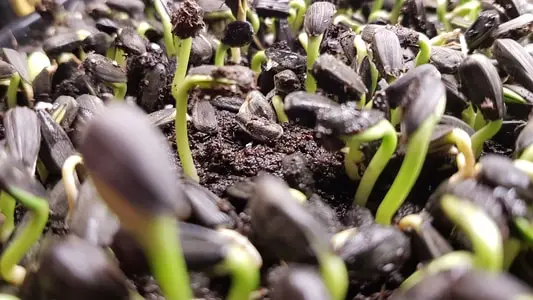 In nature, seeds naturally shed their hulls in due time. We’re interested in a few key tweaks to the natural process. As much as possible, our goals are:
In nature, seeds naturally shed their hulls in due time. We’re interested in a few key tweaks to the natural process. As much as possible, our goals are:
- Have all the seeds germinate at the same time. Half grown seedlings that haven’t shed their seed hulls complicates harvesting, and reduces yields.
- Encourage initial vigorous growth so they shed their hulls. Provide the right environment: enough water, and bright light.
ONE: Buy Pre-hulled sunflower seeds
Pre-hulled sunflower seeds are available. It’s important to be careful and make sure they’re not roasted or salted. Roasting and salting the seeds guarantees they won’t germinate, no microgreens for you!
I’ve heard mixed results with the pre-hulled seeds, but in general the reviews have been negative. I’m going to buy some and do some testing so I can present first-hand data.
TWO: Change to a different seed supplier
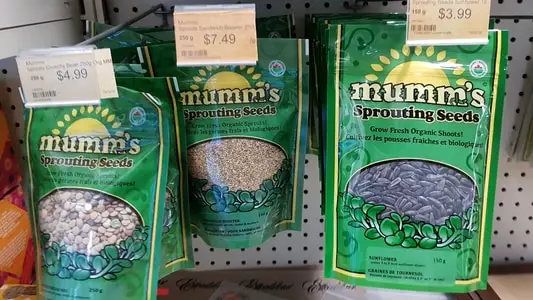 If you’re consistently having problems, you could have a bad batch of seeds. Seeds need to be harvested, stored, shipped and sold on-time and without over-heating to grow vigorously.
If you’re consistently having problems, you could have a bad batch of seeds. Seeds need to be harvested, stored, shipped and sold on-time and without over-heating to grow vigorously.
Two brick and mortar stores could sell the same brand of seeds, even the same batch, and one might germinate great and the other poorly. If a store has really low turnover, those seeds could be sitting on the shelf for a long time. High volume and turn-over is a good thing in this case.
Try switching seed suppliers, I’ve had great luck from sprouting.com (Mumm’s). But there are a lot of alternatives out there.
You want seeds specifically for sprouting and microgreens. They need to be food grade (so no bird feed), but food grade isn’t enough. You also want to make sure they’re not toasted or salted. Toasted seeds won’t germinate.
And finally, it’s worth having a quick conversation with your seed supplier. Tell them you’ve had problems with germination in the past and ask if it’s possible to get seeds from the freshest batch. They might just tell you what you want to hear and that all their seeds are fresh, but it doesn’t hurt!
THREE: Soaking Seeds
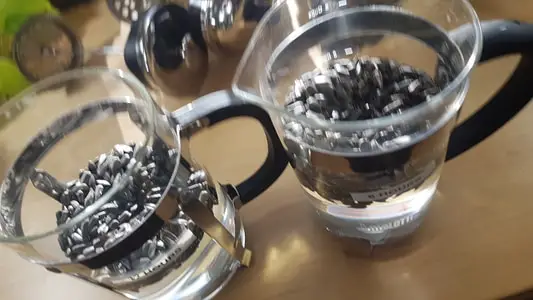 Soak the seeds by rinsing them and submerging for 6 to 18 hours. For small quantities I use a French press (for coffee). If you cycle the plunger up and down a few times it gets all the seeds in contact with water and knocks most of the air bubbles out. The idea is that evenly soaking the seeds will even out the germination.
Soak the seeds by rinsing them and submerging for 6 to 18 hours. For small quantities I use a French press (for coffee). If you cycle the plunger up and down a few times it gets all the seeds in contact with water and knocks most of the air bubbles out. The idea is that evenly soaking the seeds will even out the germination.
Seeds in soil will naturally come into contact with more or less moisture, so take different times to hydrate and sprout. By evenly soaking the seeds they should germinate and grow around the same speed.
I soak in a mixture of 50mL (3% H202) food grade hydrogen peroxide, and 1L of water. The hydrogen peroxide helps kill fungus and microorganisms on the seed hull, and is also supposed to break down the seed hull so it hydrates and sheds more easily. But I haven’t had a change to do any good experiments to compare a hydrogen peroxide soak vs pure water soak. Leave a comment below if you’ve tried this! I’m curious to hear your results.
FOUR: Use a good growing medium.
The growing medium does a few key things for microgreens. The most important is that it keeps the seeds in contact with moisture. The next is that it provides physical support for the roots, and finally it provides a little bit of nutrients, although the majority will come from the seeds during early growth.
If the growing medium isn’t even in size, with clumps and twigs and coarser texture, the seeds won’t have as even of contact. This will give you wider times to maturity, so when your tray looks ready to harvest, you’ll have more seedlings that are younger, and some will probably still have their hulls on.
I use a general purpose potting soil, it’s easy to source and gets the job done. I’ll be doing more experimenting with growing mediums in the near future.
FIVE: Top-dress with soil
If the plants aren’t growing vigorously enough to shed their seeds, you need to strengthen the plant, or make the seeds easier to shed. Burying the seeds with a 1/2 inch of soil keeps more moisture in contact with the seed hulls, water softens the hulls and makes them easier to shed.
As the plant grows the first ½ inch, the hulls are in contact with moist soil, instead of the air, so they remain softer. This makes it easier for the first leaves (cotyledons) of the sunflower seedlings to pop the hulls off.
SIX: Change seeding density
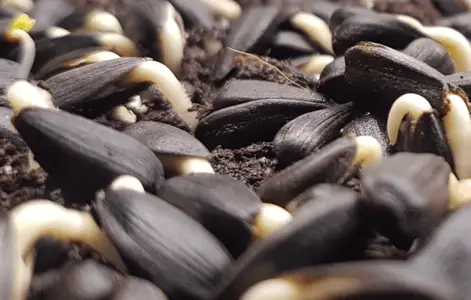 Seeding too densely or too sparsely can affect microgreen growth, and cause problems with the seeds hulls. Typical seeding density is in the 125g (4.4 ounce) to 200g (7 ounce) per 10” x 20” tray. I’ve had the best success with 150g (5.3 ounce) per 10×20 tray. You might need to adjust this if your seed batch is larger or smaller than average.
Seeding too densely or too sparsely can affect microgreen growth, and cause problems with the seeds hulls. Typical seeding density is in the 125g (4.4 ounce) to 200g (7 ounce) per 10” x 20” tray. I’ve had the best success with 150g (5.3 ounce) per 10×20 tray. You might need to adjust this if your seed batch is larger or smaller than average.
If seeds are too closely spaced, seeds will germinate right on top of each other. If the seeds or soil had any living fungal or bacterial spores, piled up seeds can trap moisture and begin to decompose. This will lower your yield, and the plants immediately surrounding any high density spots could be lost. This is why it’s good to sterilize your seeds by soaking in sodium hypochlorite, peracetic acid, or a vinegar and hydrogen peroxide solution.
An important note here is that you can mitigate this with higher ventilation, and dryer air. Installing a dehumidifier and fans shifts the environment away from favoring growth of micro-organisms. This can allow you to plant at higher densities.
If seeds are too far apart, you have the opposite problem. If too much moisture evaporates, the seeds won’t germinate. If you want to plant at lower density you can keep moisture levels up by:
- Soaking longer. I find that between 6 and 12 hours is a good range. I’m doing some testing to narrow this down! Check back soon for that article and Youtube video.
- Keeping the soil more moist initially by watering more.
- Trapping humidity by stacking trays, or using a humidity dome.
SEVEN: Stack Trays
I’ve had great results stacking seeded trays after soaking. I stack for 3.5 days on sunflower shoots, it seems like a long time, but it makes a huge difference.
To stack the trays, prepare trays how you normally would (soak, rinse, plant the seeds, topdress if you’re doing that), then press the seeds and soil down with another tray on top and put some weight on it. This creates a dark, moist, environment, and the seedlings have to exert pressure to lift the tray above as they grow.
Stacking trays traps moisture and creates a humid micro-environment. This encourages even germination, but It also helps soften the seed hulls, which helps the cotyledons shed the hulls.
After 3.5 days, the seedlings have roots, and are ready for vigorous growth. When they’re first exposed to light they’re in good shape to grow quickly and pop the hulls off. It makes a difference, I’ll do some testing on different stacking times and post a new article on this soon.
EIGHT: Humidity domes
There’s a lot of mechanical jostling which helps remove seeds post-harvest. You can brush seeds off, wash them off, and knock them off when you dry them. If some stubborn seed hulls managed to stay on your seedlings until just before harvest, you can put a clear lid (a humidity dome) on for 24 hours before harvesting.
This increased humidity softens the remaining hulls, so when you harvest they’re easier to remove. But, the downside is that it’s an extra step, and you’ll need to buy all the clear domes. It can also give microorganisms a more favorable environment.
The other problem is that any freshly popped hulls at the time of harvest will expose yellowed leaves which don’t look as good. They actually taste milder. Yellow leaves have less chlorophyll, and chlorophyll is bitter.
NINE: Heat mats
Seed hulls are porous, and water slowly makes its way in. Heat mats and watering with warmer water are two tricks to increase the speed that the seeds germinate and the hulls pop off. But, you don’t want to overdo it.
Aim for watering temperature no higher than 30C (86F), too high and you can damage the seeds.
And with heat mats, check the soil temperature if you can and try to keep it no higher than 30C (86F) as well. The ideal growing temperature seems to be between 20C (68F) and 25C (77F). Too high and microorganisms have a favorable environment, and too low and the sunflower shoots grow slower, and water doesn’t evaporate as fast, lingering and providing wet spots for fungus and pathogens to grow.
TEN: Lean your trays sideways when you harvest
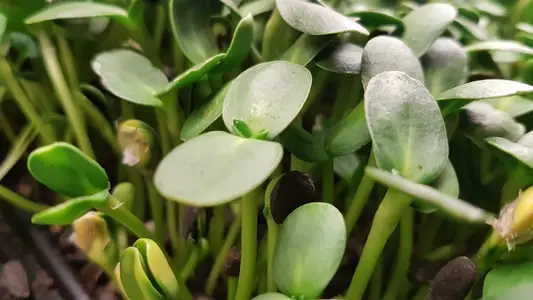 Once the cotyledons (first leaves) are fully grown, and the first true leaves start to emerge, it’s time to harvest! The picture at the right shows when it’s just about time to harvest.
Once the cotyledons (first leaves) are fully grown, and the first true leaves start to emerge, it’s time to harvest! The picture at the right shows when it’s just about time to harvest.
An easy way to knock some extra hulls off is to lean your tray up sideways. The roots will hold the growing medium together into a big matt. I tilt it up at a 45 degree or steeper angle, and then chop the greens off. But before chopping, brush your hands vigorously through the greens and knock off some hulls.
ELEVEN: Vigorous washing
Post-harvest, give the microgreens a vigorous wash. You can build a bubbler if you’re growing large volumes. It’s basically a cold jacuzzi for your plants. Otherwise use a vigorous washing. Throw into a bin and spray and agitate. The hulls float. Use a mesh grill to sink the sunflowers greens and then skim the hulls.
TWELVE: Drying Rack
When you’re done washing your microgreens, put them on a drying rack before packaging. Use a steel mesh that’s sized so seed hulls and debris will fall through, but not the microgreens. ¼ inch or 3/8 inch holes work well.
If you’re at home, a salad spinner will dry them, and you’ll probably find some seed hulls in the bottom after you take your microgreens out.
Are sunflower seed hulls toxic to other plants?
Sunflower seeds are allelopathic. This means they have biochemicals that inhibit the growth of other plants. So yes, the seed hulls can be considered toxic to other plants. Keeping this in mind, they can be a great surface cover to keep weeds down, but be careful they don’t inhibit the plants you want to grow.
One thing I’m not sure about, is how long it takes the allopathic chemicals to break down, for example when composting, or if they degrade with heat. If you know anything about this leave a comment below!
What can sunflower seed shells be used for?
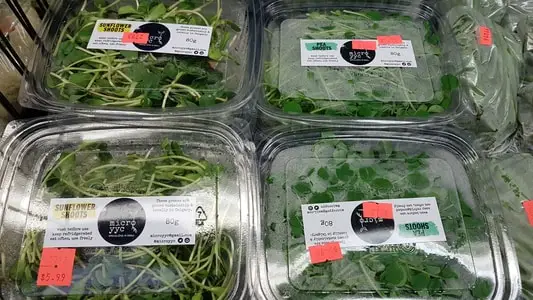 Sunflower seed hulls are black and white, fibrous covering that protect the seed’s interior so it survives long enough to germinate. The covers are a useful resource to industry, and have some uses at home as well. By recycling an otherwise wasted by-product, they’re a great example of circular economics. The principle of a circular economy is that the waste products (output) from one process are a valuable input to another.
Sunflower seed hulls are black and white, fibrous covering that protect the seed’s interior so it survives long enough to germinate. The covers are a useful resource to industry, and have some uses at home as well. By recycling an otherwise wasted by-product, they’re a great example of circular economics. The principle of a circular economy is that the waste products (output) from one process are a valuable input to another.
At home in the garden
The hulls are equipped with a chemical defense that helps sunflowers seedlings grow with a little extra breathing room. The seeds contain a chemical that leaches into the soil and inhibits the growth of other plants (allelopathy). This property makes them effective at controlling weeds if they’re spread on the surface as a mulch. Unfortunately there’s a risk when adding them to compost piles that the allelopathic biochemicals won’t break down, and could inhibit or slow growth. So, best not to compost them, at least not for use in a garden.
Livestock feed
Livestock feed needs porous material and fiber to absorb liquid additives. Sunflower seeds can be grinded and used as roughage. The roughage is low in protein and nutrients, but acts as a good organic filler and base for other feed ingredients.
Fuel source
While the hulls aren’t nutrient dense, they can be pressed into pellets, logs, or bricks and burned for their energy content. 17-18 mJ/kg is a lot of energy (source).
Next Steps
If you want to hone your microgreen skills make sure you’ve mastered the key steps:
How to Grow Microgreens in 11 Easy Steps (Updated 2020) Links to Article
Or check out one these articles for more specific advice:

I’m Alex Lafreniere. I learned a lot about plants when I built and operated a landscaping company. But, there’s always more to learn. Ever since travelling across the world, I’ve wanted to find ways to bring more tropical and exotic plants into my life. This is the site where I share everything I’ve learned with you.
This site is owned and operated by Plant Hardware, a sole proprietor headquartered in Calgary, Canada. Plant Hardware is a participant in the Amazon Services LLC Associates Program, an affiliate advertising program designed to provide a means for sites to earn advertising fees by advertising and linking to Amazon.com.Plant Hardware may also participate in affiliate programs with Bluehost, Clickbank, CJ, ShareASale, and other sites. Plant Hardware is compensated for referring traffic and business to these companies.

